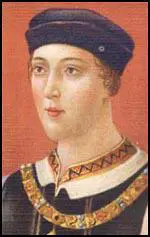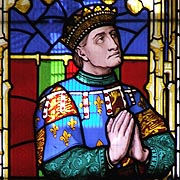Jack Cade led an ultimately unsuccessful rebellion in the south-east of England which identified Richard, Duke of York, as the popular alternative to King Henry VI.
ROAD TO REBELLION
Public mistrust of the king and his council developed after the loss of English territories on the French mainland. The territories of Maine and Anjou had been given to the French in exchange for the king's marriage to Margaret of Anjou and key negotiator, William de la Pole, Duke of Suffolk, took the blame.
Parliament impeached Suffolk but the queen's intervention led Henry VI to send Suffolk into exile. Suffolk was unable to reach the safety of Calais after being intercepted in the Straits of Dover by the ship, Nicholas of the Tower, and Suffolk was subject to a mock trial. Suffolk was found guilty of his crimes by those on board the ship and he was executed. Suffolk's decapitated body was later found on a beach in Dover, Kent.
The people of Kent, already fearful of a French invasion, became anxious over a possible reprisal for Suffolk's death and Jack Cade, the "Captain of Kent", became a figurehead.
 |
| Henry VI's mismanagement created dissent |
Cade's manifesto 'The Complaint of the Poor Commons of Kent' detailed numerous grievances towards the king for promoting and accepting the word of corrupt officials. The manifesto detailed Kent's innocence towards Suffolk's execution and demanded the removal of the king's "friends" and if the king refused, Cade would "destroy" him and replace Henry VI with the Duke of York.
Kent officials close to the king, including James Fiennes, Lord Saye, and his son-in-law William Crowmer, were accused by Cade of election rigging and extortion. Saye and Crowmer had served as sheriffs of Kent and were members of the king's council, with Saye appointed Lord Treasurer in 1449.
Henry VI didn't respond to the manifesto and on 24 May 1450 hundreds of armed men gathered at Ashford and Cade towards London. Cade's origins are unknown but it was believed he was born in Ireland in the 1420s, served in the household of a Sussex knight and fought in France. His military experience became vital in organising his troops to rebel against the king.
"AMEND-ALL"
Cade was known by his followers as "John Mend-all" or "John Amend-all" due to his willingness to hear people's complaints and restore order. Cade now took on the alias "John Mortimer" to appeal to York and his followers who were descended from Edmund Mortimer, the named heir of Richard II who was deposed by Henry IV, the grandfather of the current king.
 |
| Cade appealed to Duke of York by taking his descendants' name |
Cade's men numbered 5,000 in early June 1450 as they encamped at Blackheath, 12 miles southeast of the capital. The rebels varied from local traders, farmers and sailors to a knight who had fought at Agincourt, three sheriffs and two members of Parliament. Cade sent Henry VI a copy of his manifesto to explain his terms to the king's representatives but the Council rejected all of the demands and the king ordered the army to disperse.
The rebels retreated to Sevenoaks in Kent and waited for reinforcements from nearby Sussex. The king was advised to lead the royal forces against the rebels but the queen, fearful of Henry VI's safety, convinced him to send the Stafford brothers, Sir Humphrey and William, to command the royal forces at Sevenoaks. The Battle of Sevenoaks lasted two hours with heavy losses on both sides but the deaths of the Staffords brought victory to the rebels. The royal couple fled to Greenwich and Lord Saye refused the queen's wish for him to accompany them, knowing that the rebels would hotly pursue them.
The king ordered Saye and Crowmer to be placed in custody for their own protection and Henry VI fled London to Kenilworth, Warwickshire, leaving Cade to march on London. Unrest broke out in Wiltshire where William Ayscough, Bishop of Salisbury, and the king's confessor, was attacked by his congregation in Edington Church and murdered. The much-hated bishop was a close ally of Suffolk and was blamed for the lack of a royal heir after instructing the king to avoid marital sex whenever possible.
LORD OF THE CAPITAL
Cade, clad in Stafford's armour, arrived on the south bank of the Thames and took up residence in the White Hart Inn in Southark. The next day, Cade crossed London Bridge dressed as a pretender in a blue velvet gown and gilded spurs, whilst holding a gold nail- studded shield and a sword. Cade cut the drawbridge ropes to prevent it to be raised against him and, once in the capital, lightly struck the London Stone with his sword and cried out, "Now is Mortimer lord of this city!"
 |
| James Fiennes, Lord Saye, is brought before Jack Cade (Charles Lucy) |
The rebels focused on the imprisoned Kentish lords and Crowmer was taken from Fleet Prison by Cade and Saye was dragged from the Tower to face trial at the Guildhall. The lords were found guilty, executed and Saye's naked body was bound and tied to a horse to be paraded around the capital. The heads of the two lords were put on pikes and their bearers pushed them together to make them 'kiss' and the crowd roared with laughter.
TRAITOR
Cade's men soon became rowdy and their triumphant leader forgot his promises to his respectful followers that he wouldn't loot the capital and lost local support. After Cade's army returned to Southwark via London Bridge for the night, the London officials closed the bridge to prevent Cade from re-entering the city.
| The overnight battle over London Bridge lasted 10 hours |
The next evening saw Cade trying to gain entry back into the city and he was repulsed by Captain Matthew Gough's garrison from the Tower. A furious battle broke out at 10pm on London Bridge, lasting an exhaustive 10 hours that left Gough dead and Cade in retreat.
Cardinal Kempe was sent on behalf of the government to negotiate with Cade and the Cardinal promised royal pardons and agreed to the demands of the Cade's manifesto. Pardons were issued and the rebels dispersed but Cade refused to withdraw until the demands were agreed in Parliament. Cade's pardon was revoked after it was revealed his pardon had been awarded to his alias, John Mortimer, and he was declared a traitor on 10 July with a 1000-mark bounty on his head.
Cade's supporters deserted him and Cade fled to Lewes, Sussex, but was cornered by Kent sheriff, Alexander Iden, in Heathfield, East Sussex, on 12 July 1450. Iden took Cade back to London after defeating him in a fight but his captive died of his wounds before he reached the capital.
 |
| Jack Cade's memorial plaque on Cade Street, Heathfield in Sussex |
The Council was doubtful that Iden had caught the right man until the innkeeper's wife at the White Hart identified Cade's body. Cade was beheaded and his spiked head was placed on London Bridge looking towards Kent as a warning. The royal couple had returned to the capital on 10 July and Henry VI looked to punish the rebels. The king passed judgement on the deaths of the captured rebels, eight at Cantebury and 26 at Rochester in what became know as the 'harvest of heads'.
Cade's Rebellion was unsuccessful thanks to Cade's hubris and lustful troops but it showed that Henry VI was vulnerable. York observed from his seat in Ireland that Henry VI was easily influenced, left London to the mercy of rebels and that public opinion was against the royal court. These flaws would be further examined over the next 20 years as York and his supporters vied with the Lancastrians for the throne by arguing demands and reform policies seen in Cade's manifesto.

No comments:
Post a Comment